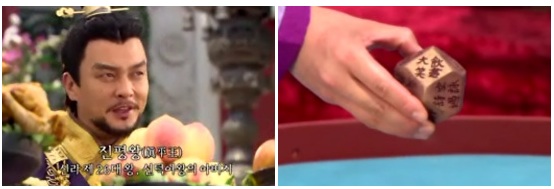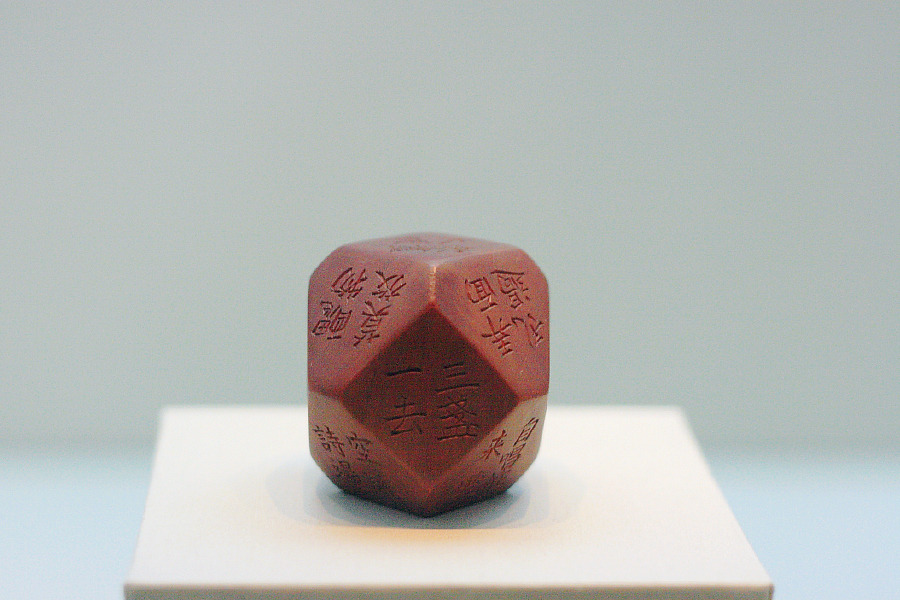KPOP Jacket Lady
KDrama and KPOP Concert Reviews, Travel Tips, Korean Recipes and more
Juryeonggu: A 14 Sided Die From The Golden Age Of Silla.

During an archaeological dig in 1975 a 14 sided die was uncovered in a pleasure pond used by royalty of the Unified Silla Period. (about 668 to 935 AD.) The wooden die was unusual in that not only were the sides made up of 6 square and 8 semi-triangular faces, but each face had Chinese characters incised into the surface, which when translated proved to be instructions for a drinking game! (Note that up until fairly recently Hanja, Chinese script, was used in S. Korea as well as Hangul, the Korean alphabet, which was invented in the 15th century, so finding a die with Chinese script does not mean it wasn’t a Korean die.)
The die was found in the city of Gyeongju which is also known as the most historic city in S.Korea due to the extensive number of historical remains. Many think of the city and surrounding area as being the most important cultural site in S. Korea, and it is the 3rd most visited tourist site after Seoul and Busan. Gyeongju was also important in the past and particularly during its’ ‘golden age’ (approx 600-800 AD) and was possibly one of the 5 largest cities in the world at that time. It had extensive trading ties, including to China and Japan, and was known to be a creative and vibrant city, with a wealthy and educated upper class.

And wealthy people often have leisure time which needs to be filled, with games being a perfect way to socialize and pass the time. Each of the sides of the die had penalties or tricks that one was to perform, EumJuGaMu (food,drink,song,dance) was an acceptable way to pass time, and it is supposed that the juryeonggu added a touch more luck and fun to the overall entertainment.


Korean drama fans may have seen replicas of this die show up in Sageuk such as in episode 6 of Queen Seondeok, and episode 1, and others, of Hwarang, The Flower Boys of Silla, but the really sad thing is that the original die they found in 1975 was destroyed while they were trying to preserve it. Only one has ever been found and it no longer exists. Hopefully another die will show up in future excavations, although wood tends only to survive long periods of time in anaerobic (oxygen free) conditions.
Fortunately photographs were taken before the die was destroyed which has enabled replicas to be made. I have heard that you can buy replica dice and even a paper make your own, but I haven’t found a source as yet. I’d love a slightly more modern one, as in written in Hangul, or even a blank one so I could write on it in English. If anyone finds a source for a replica die please let me know. EDIT. A Korean friend found a hand made replica pair, one with original script, the other blank so I can have instructions in English engraved into it. Thanks Ken.
One of the replica dice is shown above, but I can’t find out if they used these colors because they found traces on the original die, or if it was artistic licence. This one is now in the National Museum of Korea.
This replica can be seen in the National Gyeongju Museum and I think looks closer to the photograph taken of the original before it was accidentally destroyed, but with the original photos being in black and white it is hard to be sure.
I have since found a partial description that said it was black lacquer over hardwood oak, so maybe the black replica is more accurate? One report says it was 5.5 cm x 4 cm but I’m not sure if that is accurate as that seems small compared to what they show on the dramas and they must have based their version off of some information. I would love to see the original report on the die available in translation to see what it said about the die itself.

The juryeonggu shape is so famous in Gyeongju that lanterns are made in the same shape, as are bread snacks.
If I happen to find a source for buying replica juryeonggu I will post it here, until then I may try and find a blank die in another shape and create my own drinking game.
Have a great day everyone.
Photo credits to original owners. National Museum of Korea. Gyeongju National Museum.
Please do not copy or use without permission and accreditation.
You may also like Yut, Alkkagi, Jegi Chagi, and Hwarang, The Flower Boys of Silla.


Pingback: Hwarang: The Flower Boys of Silla. | KPOP Jacket Lady
Pingback: Alkkagi: A Korean Game. | KPOP Jacket Lady
Pingback: K-dramas, My Picks For 2016. | KPOP Jacket Lady
Pingback: Traditional Sledding In Korea. | KPOP Jacket Lady
Pingback: Korean Games, And Where To Find Out More About Them. | KPOP Jacket Lady
Pingback: Korea And The Silk Road. – KPOP Jacket Lady
Pingback: Gyeongju: Why You Should Visit On Your Next Trip To Korea. – KPOP Jacket Lady
I am also interested in finding a juryeongoo dice. Please let me know if you find a source or know of anyone that can make a reproduction. Thanks.
LikeLike
Will do, and thanks for reading.
LikeLike
Pingback: Wolji Pond At Night: In Photos. – KPOP Jacket Lady
Pingback: Silla: Korea’s Kingdom of Gold. – KPOP Jacket Lady
Pingback: Juryeonggu – Dado de 14 lados da Era Silla da Coréia – Konfide.Education
The game in traditional wood with no inscriptions can be purchased at that the National Museum of Korea in Seoul
LikeLike
Thank you Babette. I was given a blank one and one inscribed as the original was, so I’m ok for now. Will probably buy a couple more for friends next time I visit the National Museum in Seoul. Have a good day.
LikeLike
I bought a replica juryeonggu from a guy selling soyvenirs in a roadside parking lot near the Gyeongju national museum. That was 4 years ago or so, but if you look around you’ll probably find one there. Mine is cast resin, stained brown, and the writing is in Hangul, not Hanja.
LikeLike
Thanks, I finally got a couple of wooden replica ones, but will keep my eyes out for a resin one. Thanks for letting me know.
LikeLike